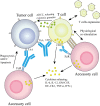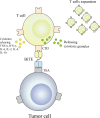Immunotherapeutic progress and application of bispecific antibody in cancer
- PMID: 36341333
- PMCID: PMC9630604
- DOI: 10.3389/fimmu.2022.1020003
Immunotherapeutic progress and application of bispecific antibody in cancer
Abstract
Bispecific antibodies (bsAbs) are artificial antibodies with two distinct antigen-binding sites that can bind to different antigens or different epitopes on the same antigen. Based on a variety of technology platforms currently developed, bsAbs can exhibit different formats and mechanisms of action. The upgrading of antibody technology has promoted the development of bsAbs, which has been effectively used in the treatment of tumors. So far, 7 bsAbs have been approved for marketing in the world, and more than 200 bsAbs are in clinical and preclinical research stages. Here, we summarize the development process of bsAbs, application in tumor treatment and look forward to the challenges in future development.
Keywords: antibody constructs; bispecific antibody; bsAb; clinical trials; tumor immunotherapy.
Copyright © 2022 Kang, Sun and Zhang.
Conflict of interest statement
The authors declare that the research was conducted in the absence of any commercial or financial relationships that could be construed as a potential conflict of interest.
Figures





Similar articles
-
A review of bispecific antibodies and antibody constructs in oncology and clinical challenges.Pharmacol Ther. 2019 Sep;201:103-119. doi: 10.1016/j.pharmthera.2019.04.006. Epub 2019 Apr 24. Pharmacol Ther. 2019. PMID: 31028837 Review.
-
Bispecific Antibodies: From Research to Clinical Application.Front Immunol. 2021 May 5;12:626616. doi: 10.3389/fimmu.2021.626616. eCollection 2021. Front Immunol. 2021. PMID: 34025638 Free PMC article.
-
Challenges and strategies for next-generation bispecific antibody-based antitumor therapeutics.Cell Mol Immunol. 2020 May;17(5):451-461. doi: 10.1038/s41423-020-0417-8. Epub 2020 Apr 20. Cell Mol Immunol. 2020. PMID: 32313210 Free PMC article. Review.
-
Current landscape and future directions of bispecific antibodies in cancer immunotherapy.Front Immunol. 2022 Oct 28;13:1035276. doi: 10.3389/fimmu.2022.1035276. eCollection 2022. Front Immunol. 2022. PMID: 36389699 Free PMC article. Review.
-
Bispecific antibodies targeting immunomodulatory checkpoints for cancer therapy.Cancer Biol Med. 2023 Mar 24;20(3):181-95. doi: 10.20892/j.issn.2095-3941.2023.0002. Cancer Biol Med. 2023. PMID: 36971124 Free PMC article. Review.
Cited by
-
Bispecific Antibodies, Nanobodies and Extracellular Vesicles: Present and Future to Cancer Target Therapy.Biomolecules. 2025 Apr 29;15(5):639. doi: 10.3390/biom15050639. Biomolecules. 2025. PMID: 40427532 Free PMC article. Review.
-
A new EGFR and c-Met bispecific NIR-II fluorescent probe for visualising colorectal cancer and metastatic lymph nodes.EBioMedicine. 2025 May;115:105687. doi: 10.1016/j.ebiom.2025.105687. Epub 2025 Apr 17. EBioMedicine. 2025. PMID: 40250245 Free PMC article.
-
Macrophage-engaging peptidic bispecific antibodies (pBsAbs) for immunotherapy via a facile bioconjugation strategy.Chem Sci. 2024 Apr 30;15(29):11272-11278. doi: 10.1039/d4sc00851k. eCollection 2024 Jul 24. Chem Sci. 2024. PMID: 39055004 Free PMC article.
-
Fragment-Based Immune Cell Engager Antibodies in Treatment of Cancer, Infectious and Autoimmune Diseases: Lessons and Insights from Clinical and Translational Studies.Antibodies (Basel). 2025 Jun 24;14(3):52. doi: 10.3390/antib14030052. Antibodies (Basel). 2025. PMID: 40700292 Free PMC article. Review.
-
Principles and current clinical landscape of NK cell engaging bispecific antibody against cancer.Hum Vaccin Immunother. 2023 Aug;19(2):2256904. doi: 10.1080/21645515.2023.2256904. Epub 2023 Sep 29. Hum Vaccin Immunother. 2023. PMID: 37772505 Free PMC article. Review.
References
Publication types
MeSH terms
Substances
LinkOut - more resources
Full Text Sources
Medical

